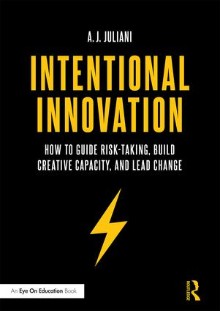Guiding Risk-Taking to Build Creativity
Intentional Innovation: How to Guide Risk-Taking, Build Creative Capacity, and Lead Change
By A.J. Juliani
(Routledge/Eye On Education, 2018 – Learn more)

Our world is vastly different than it was even one generation ago, and it is continuing to change at an exponential rate.
Students of today will have to be creators, innovators and entrepreneurs as future problems emerge and technology reshapes the job market again and again.
Innovation is a must. In this book A.J. Juliani discusses the way we learn, how brain connections are changing in our “connected” world, and how we can be intentional with our innovation (how we do things differently, not necessarily using new technology).

Attention spans have dropped drastically. We no longer encode information in terms of just our experiences but also using the experiences of others. We no longer need to store information (we have computers in our hands for that). Retrieval no longer has to do with remembering, but rather is based on our ability to find the information in external storage (a device vs. our brain).
Juliani further notes that if we continue to use standardized assessments as our measure of success, we (teachers) will be replaced by machines that can better tailor instruction and raise individual scores on standardized tests. If we follow this course, our students will be trained for historical jobs rather than future ones.
What hasn’t changed about learning is that it is a social process, and relationships continue to be the key to increased learning, something only humans can do.
Helping students become risk takers
Being successful is no longer about what you know, but what you can do with what you know. We must teach our students to be better risk takers so that they can become creators, innovators and entrepreneurs. Unfortunately, in most of our schools risk taking is punished (often inadvertently) because of our management structures and accountability measures.
Juliani uses the acronym PLASMA (Praise, Look for, Assess, Support, Allow) to emphasize that what we pay attention to, measure, and praise is what we are marking as “This Matters Most.” And when we focus on grades and standardized testing, we are sending the message that the important things are being compliant, completing tasks designed by others, and submitting them on time.
Making failure normal
He goes on to give us simple things that we can easily incorporate into our classrooms to shift this trend and further discusses the importance of making failure normal (without failure there is no progress), and making it okay not to know something (even for the teacher, who should be one of the learners in the room, modeling life-long learning).
The education community has been talking about innovation and the changing world for some time now, but change in education continues to be limited to “pockets of innovation.” Juliani discusses why this is the case and gives us some simple things that we can do to shift from islands of innovation to school systems that are innovative as a matter of course, with innovation being the norm rather than the exception in educational practice.
This book presents a very interesting exploration of “being innovative” with some good suggestions of easy actions we can take to prepare our students for their futures.
Dr. Laura Von Staden is currently a Middle School Gifted Math and Science teacher in Tampa, Florida. She serves on numerous committees in her school district, works closely with the local university, and writes curriculum. She is also a professional development consultant, and previously served as an Exceptional Student Education Specialist, and as a mentor.



































